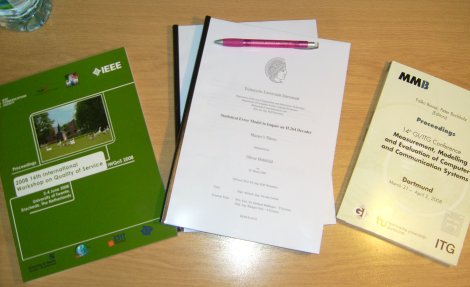Oliver Hohlfeld
Professor, Distributed Systems Group, University of Kassel
Master Thesis: Statistical Error Model to Impair an H.264 Decoder

Download
A PDF version of the thesis can be downloaded here. Note that Chapter 5 is excluded from this version due to a possible patent application.
- Hohlfeld, Oliver: Statistical Error Model to Impair an H.264 Decoder Master Thesis KOM-D-0310, Multimedia Communications Lab, Darmstadt University of Technology, March 2008. PDF
Awards
- 2009 - KuVS Master’s Thesis Award (Award Homepage)
Communication in Distributed Systems (KuVS) Group - 2010 MMB Master Thesis Award (Award Homepage)
Abstract
With provisioning of broadband access for mass market even in wireless and mobile networks, multimedia content, especially real-time streaming of high-quality audio and video, is extensively viewed and exchanged over the Internet. Quality of Experience (QoE) aspects, describing the service quality perceived by the user, are a vital factor in ensuring customer satisfaction in today’s network services. Creating frameworks for accessing quality degradations in streamed video currently is investigated as a complex multi-layered research topic, involving network traffic load, codec functions and measures of user perception of video quality.
Within this area, the present thesis focuses on packet loss models and corresponding impairments in real-time transmissions of H.264 encoded video streams. Based on backbone traffic and DVB-H packet loss traces, stochastic models for the packet loss process are evaluated and discussed. The aim is to provide a Markovian generator for packet loss pattern for studying the impact of imparements on the Quality of Experience. As traffic measurements on backbone links rarely contain packet losses, a set of typical loss pattern was introduced by simulating a tail-drop queue on a router’s link interface feeded by observed traffic, where smaller forwarding capacity is assumed to obtain higher load levels. The approach is appropriate for UDP traffic, whereas the much more complex TCP rate control and its impact on traffic variability was left for further study. The resulting packet loss process and the impact of queue dimensioning on the packet loss process, are discussed.
The main contribution of the Master thesis is a new parameter estimation technique for Markovian point processes. Second-order statistics for the distribution of the number of lost packets over multiple time-scales are derived from moment generating functions and moment matching is used to adapt a Markov process to error pattern observed in multiple time-scales. The second order statistics in multiple time-scales is equivalent to the autocorrelation function of a process. An explicit analytical expression is derived for the Gilbert-Elliott model to compute the statistics on arbitrary scales based on four parameters, which gives clear insight for the reverse process of parameter adaptation to observed statistics in relevant time scales.
The experience in applying the results to loss processes from several sources suggest that the classical 2-state Gilbert-Elliott model already captures a wide range of observed loss pattern. The proposed approach leads to a closer match in multiple time scales than classical methods with more flexibility to include information from different time scales, enabling a simple and useful fit for long traces of traffic and packet loss processes. There is a large amount of work utilizing the Gilbert-Elliott model, focusing on fitting error run and gap lengths rather than long term correlation.
The analytical study of loss pattern is supplemented with a qualitative investigation of their effects on QoE metrics for video transmission. In general, impairments of video sequences are sensitive to different assumptions on loss processes yielding different reaction in coding of slices and frames, which stresses the importance of refering to the most relevant pattern.
A reference set of error processes was obtained from Gilbert-Elliott models correnponding to traffic profiles at different load versus error rate levels with additional parameters being adapted to observed loss pattern statistics. The set is used for impairment of H.264 encoded, high definition (HD) IPTV video streams in order to derive properties of impaired and unimpaired HDTV video sequences. A comparison of 2400 impaired video sequences led to strong evidence that uniform packet losses produce a larger distortion than busty packet losses at the same and sufficiently high rate, since the former affect more frames on the video coding layers. Moreover, the results suggest that created impairments at the video layer are affected by the applied parameter estimation technique.
Publications
Two conference paper, one journal paper and one extended abstract cover parts of my thesis:
- Conference Paper: Hohlfeld, Oliver; Geib, Rüdiger; Hasslinger, Gerhard: Packet Loss in Real-Time Services: Markovian Models Generating QoE Impairments
In: Proc. of 16th International Workshop on Quality of Service (IEEE IWQoS), pp. 261-270, 2008.
PDF Conference DOI - Conference Paper: Hasslinger, Gerhard; Hohlfeld, Oliver: The Gilbert-Elliott Model for Packet Loss in Real Time Services on the Intern et
In: Bause, F. & Buchholz, P. (ed.): Proceedings of the 14th GI/ITG Conference on Measurement, Modeling, and Evaluation of Computer and Communication Systems (MMB), pp. 269-283, 2008.
PDF Conference - Journal Paper: Hohlfeld, Oliver: Stochastic Packet Loss Model to Evaluate QoE Impairments
In: PIK Journal, pp. 53 - 56. Number 1, 2009. (ISSN 0930-5157)
PDF Journal - Extended Abstract: Hohlfeld, Oliver: Stochastic Packet Loss Model to Evaluate QoE Impairments
In: K. David and K. Geihs: KiVS 2009, series Informatik aktuell. Springer, 2009, p. 320.
PDF

Address:
Oliver Hohlfeld
University of Kassel
Distributed Systems Group
Wilhelmshöher Allee 73
34121 Kassel, Germany MapEmail: oliver dot hohlfeld at uni-kassel /DOT/ de
- My group
- Chair of Computer Networks
- Social
- ResearchGate
- @ohohlfeld Twitter
- Publications
- DBLP
- Google Scholar
 Netray Internet Observatory
Netray Internet Observatory
- netray.IO
- QUIC Adoption
- HTTP2 Adoption
- TCP Initial Window Configurations
- Certificate Authority Authorization (CAA)